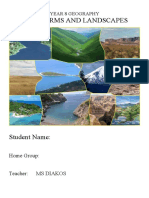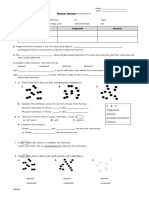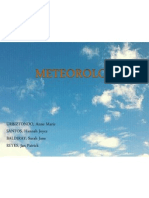Chapter 2.1
Uploaded by
giaChapter 2.1
Uploaded by
giaLife on Planet Earth 2.
1
In our solar system, only a single planet—Earth—is teeming with millions
of species. Earth is home to countless organisms and habitat types. A habitat
is the place where an organism lives. Habitats may be terrestrial, on the
land, or aquatic, in the water. In the oceans, life ranges from colourful fish
on coral reefs to strange creatures living in the dark depths. On land, there
are cacti and rattlesnakes in the arid deserts. Enormous trees swarm with
insects in the tropical rainforests (Figure 1). Low-lying shrubs and herds of
caribou abound in the frozen Arctic. What features of Earth permit such a
diversity of life to exist?
(a) (b)
Figure 1 Earth is home to countless habitats, including (a) deserts and (b) tropical rainforests.
The Spheres of Earth
Earth is a medium-sized planet orbiting our Sun (a star) at a distance of
approximately 150 000 000 km. Viewed from space, Earth appears as a pale
blue dot (Figure 2). As you near Earth, you will notice it is surrounded
by a thin gaseous layer swirling with clouds. Finally, you will be able to
distinguish the oceans, land, and ice that cover Earth’s surface.
The Atmosphere, Lithosphere, and Hydrosphere
Earth’s mass creates a force of gravity strong enough to hold gases near its
surface. In contrast, the force of gravity of our Moon is not strong enough
to hold gases. Earth’s atmosphere is the layer of gases extending upward for
hundreds of kilometres. It is made up of about 78 % nitrogen gas and 21 % Figure 2 Earth looks like a pale blue
oxygen gas. The remaining <1 % of the atmosphere includes argon, water dot when viewed from space.
vapour, carbon dioxide, and a variety of other gases.
The atmosphere is critical to life on Earth. It acts like a blanket and atmosphere the layer of gases
surrounding Earth
moderates surface temperatures. The insulation prevents excessive heating
during the day and cooling during the night. Without an atmosphere,
Earth’s surface temperature would drop from the 15 °C average it is now
to approximately –18 °C. In addition, Earth’s atmosphere blocks some
incoming solar radiation, including most ultraviolet light, which is linked
to skin cancer. Without the atmosphere, most of Earth’s species would be
unable to survive.
NEL 2.1 Life on Planet Earth 29
6646_Sci9_ch02_pp20-37.indd 29 7/17/09 12:36:53 PM
Scientists use a number of terms to describe Earth’s key surface
lithosphere Earth’s solid outer layer components. The lithosphere is the rocky outer shell of Earth. It consists of
the rocks and minerals that make up the mountains, ocean floors, and the
rest of Earth’s solid landscape. The lithosphere ranges from about 50 to
150 km in thickness.
hydrosphere all of Earth’s water in solid, The hydrosphere consists of all the water on, above, and below Earth’s
liquid, and gas form surface. It includes oceans, lakes, ice, groundwater, and clouds. Nearly all the
water on Earth (97 %) is contained in the oceans.
The Biosphere
biosphere the zone around Earth where Scientists use the term biosphere to describe the locations in which life can
life can exist exist within the lithosphere, atmosphere, and hydrosphere (Figure 3).
Most of the easily observed life forms exist on land and in water, but
micro-organisms exist several kilometres beneath Earth’s surface.
atmosphere
biosphere
hydrosphere lithosphere
Figure 3 Earth’s biosphere is found in
regions of the atmosphere, lithosphere,
and hydrosphere.
LEARNING TIP Earth is very large (about 12 700 km in diameter), but the biosphere is
It’s All Greek to Me very thin by comparison. All conditions required for life must be met and
Many scientific terms are derived from maintained within this thin layer of ground, water, and lower atmosphere.
Greek. Lithos means stone, atmos All living things need space, water, and nutrients to survive. However, the
means vapour, hydro means water, bio supply of these resources is limited. Ultimately, the availability of resources
means life, and sphere means ball.
places a limit on the number of individuals of a species that can survive. All
life on Earth is vying for access to these precious resources. The struggle for
resources is discussed in Section 2.7.
The Gaia Hypothesis
READING TIP In the 1960s, scientist James Lovelock advanced the Gaia hypothesis. He
Text-to-Text Connections proposed that Earth, through interactions among the biosphere, lithosphere,
Brainstorm text-to-text connections by atmosphere, and hydrosphere, behaved like a living organism. Lovelock’s
jotting down everything that comes to hypothesis suggested that Earth was capable of responding to changes in its
mind when you think about the selection environment (such as incoming sunlight) and maintaining relatively consistent
and texts you have read. You can use
a Venn diagram to list similarities and
internal conditions over long periods of time—just like a living cell.
differences between the selection and The Gaia hypothesis is not widely accepted as a rigorous scientific concept.
other texts. However, many people feel that thinking of Earth as a living thing may
encourage and promote a more caring attitude toward our planet and the life
it supports.
30 Chapter 2 • Understanding Ecosystems NEL
6646_Sci9_ch02_pp20-37.indd 30 7/17/09 12:36:56 PM
T RY THIS A SCALE MODEL OF PLANET EARTH
SKILLS: Analyzing, Communicating SKILLS HANDBOOK
5.A.1.
To appreciate how the lithosphere, atmosphere, and hydrosphere Table 1
compare to the overall size of Earth, it is useful to consider a Feature measurement Actual distance Model distance
scale model of Earth. The diameter of Earth at the equator is thickest portion of 150 km 12.8 mm
approximately 12 700 km. Imagine a model of Earth with a lithosphere
diameter of 1 m, like a very large beach ball. Each distance of distance between 1380 km
1 mm on the model of Earth would represent a distance of Toronto and Thunder Bay
12.7 km on the true Earth. In this activity, you will create a scale average ocean depth 3.7 km
model to compare the size of Earth’s components. maximum ocean depth 10.9 km
1. Draw a table similar to Table 1 and fill in the missing values. height of Mount Everest 8.4 km
For example, the thickest portion of the lithosphere at average thickness of 1.6 km
Antarctic ice
150 km would be equivalent to 150 or 12.8 mm on
12.7 thickness of lower 20 km
our model. T/I C atmosphere
MATH TIP
To keep the model consistent, divide every value by the C. In our Earth model, all life would exist within 1 mm of the
same number. Therefore, 1 mm always equals 12.7 km. surface. Given this information, would it surprise you to
learn that many scientists consider the ocean, atmosphere,
A. Did the model distances surprise you? Which model
and biosphere to be very vulnerable to pollution and other
distances, if any, were less than you had expected?
forms of damage? A
Which, if any, were greater? A
B. Based on the same scale, the volume of Earth would be
520 L, but the volume of all the world’s oceans would be
only 640 mL. This is not enough to fill two pop cans. If this
is the case, why do you think Earth is often referred to as
the watery planet? A
IN SUMMARY
• Earth’s atmosphere is made up of about 78 % • The hydrosphere is Earth’s water in all its forms.
nitrogen gas, 21 % oxygen gas, and other gases. • The biosphere is the area where life can exist
• The atmosphere moderates surface temperatures within the lithosphere, atmosphere, and
and blocks some incoming solar radiation. hydrosphere.
• The lithosphere is Earth’s solid outer shell. • The Gaia hypothesis proposes that Earth behaves
like a living organism.
CHECK YOUR LEARNING
1. Explain how Earth’s mass is related to its ability to have an 5. If Earth is so large, why do scientists consider the biosphere
atmosphere. K/U to be fragile? Explain. K/U A
2. In what way does the presence of an atmosphere enhance 6. It can be difficult to appreciate the relationships of large
conditions for life on Earth’s surface? K/U objects such as Earth. How does using a scale model make
3. Define each of the following terms: lithosphere, atmosphere, these relationships easier to understand? T/I C
hydrosphere, and biosphere. K/U 7. What surprised you most about the physical makeup
4. Describe the ways in which Earth’s “spheres” overlap of Earth’s spheres and the relationships among them? C
each other. K/U C
NEL 2.1 Life on Planet Earth 31
6646_Sci9_ch02_pp20-37.indd 31 7/17/09 12:36:59 PM
You might also like
- Full Download Environmental Science Experiments Experiments for Future Scientists 1st Edition Aviva PDF DOCX100% (5)Full Download Environmental Science Experiments Experiments for Future Scientists 1st Edition Aviva PDF DOCX85 pages
- Evidence Chart: Evidence What It Tells UsNo ratings yetEvidence Chart: Evidence What It Tells Us2 pages
- Rock Cycle Webquest!: Igneous, Metamorphic or Sedimentary?No ratings yetRock Cycle Webquest!: Igneous, Metamorphic or Sedimentary?4 pages
- Laura Trout Editor POGIL Activities for AP Biology 2012-2-2100% (1)Laura Trout Editor POGIL Activities for AP Biology 2012-2-2253 pages
- 5.1 Properties and Changes - Matter ReviewNo ratings yet5.1 Properties and Changes - Matter Review2 pages
- Science 20F: Chemistry Exam Review 1 of 6No ratings yetScience 20F: Chemistry Exam Review 1 of 66 pages
- Grade 10 Optics Unit Outline Vandanabathlagrade910science - CompressNo ratings yetGrade 10 Optics Unit Outline Vandanabathlagrade910science - Compress7 pages
- TX 5.8B TheSunandWaterCycle EXPLAIN STEMscopediaNo ratings yetTX 5.8B TheSunandWaterCycle EXPLAIN STEMscopedia6 pages
- Greenhouse Gases and Human Activities: Snc2DNo ratings yetGreenhouse Gases and Human Activities: Snc2D7 pages
- Domains and Kingdoms Spring Break ProjectNo ratings yetDomains and Kingdoms Spring Break Project2 pages
- Earth Science - Tarbuck - Chapter 5 - Running Water and Groundwater100% (1)Earth Science - Tarbuck - Chapter 5 - Running Water and Groundwater40 pages
- Name - Earth Science Wind/Pressure/Weather Webquest Part 1. Air MassesNo ratings yetName - Earth Science Wind/Pressure/Weather Webquest Part 1. Air Masses5 pages
- URBIZTONDO, Anne Marie SANTOS, Hannah Joyce BALDIRAY, Sarah Jane REYES, Jan PatrickNo ratings yetURBIZTONDO, Anne Marie SANTOS, Hannah Joyce BALDIRAY, Sarah Jane REYES, Jan Patrick21 pages
- Second Lectuer History and Development of NursingNo ratings yetSecond Lectuer History and Development of Nursing17 pages
- Cisco Aironet 3800 Series Access Points Getting Started GuideNo ratings yetCisco Aironet 3800 Series Access Points Getting Started Guide46 pages
- M.A. Psychology First Year Practical File MPCL-00750% (2)M.A. Psychology First Year Practical File MPCL-00754 pages
- 03 11 2024 - SR - Super60 - NUCLEUS&STERLING BT - Jee Adv (2020 P2) - CTA 08&15 - Q.PaperNo ratings yet03 11 2024 - SR - Super60 - NUCLEUS&STERLING BT - Jee Adv (2020 P2) - CTA 08&15 - Q.Paper20 pages
- CE8394 Fluid Mechanics and Machinery MCQNo ratings yetCE8394 Fluid Mechanics and Machinery MCQ39 pages
- Lexber Inc. V Sps. Dalman G.R. No. 183587, April 20, 2015No ratings yetLexber Inc. V Sps. Dalman G.R. No. 183587, April 20, 201514 pages
- History of Philadelphia International AirportNo ratings yetHistory of Philadelphia International Airport3 pages
- 22 - AE - 111 - Module - 3 - Recording - Business - TransactionsNo ratings yet22 - AE - 111 - Module - 3 - Recording - Business - Transactions23 pages
- Lesson 5: Introducing Yourself : Yeray Vladimir Gonzalez SilvaNo ratings yetLesson 5: Introducing Yourself : Yeray Vladimir Gonzalez Silva20 pages
- Atashi No Onii-Chan Dekita! Onii-Chan7313No ratings yetAtashi No Onii-Chan Dekita! Onii-Chan73131 page
- Organized Labor and the Black Worker, 1619-1981 Philip S. Foner - Own the ebook now with all fully detailed content100% (1)Organized Labor and the Black Worker, 1619-1981 Philip S. Foner - Own the ebook now with all fully detailed content50 pages
- Budapest Ceenet 2001 - Satellite CommunicationsNo ratings yetBudapest Ceenet 2001 - Satellite Communications93 pages
- Aro Bareilly Recruitment Notification For Agniveer Men 2024-25 Dirzro CC-1707721600No ratings yetAro Bareilly Recruitment Notification For Agniveer Men 2024-25 Dirzro CC-170772160023 pages

























































































